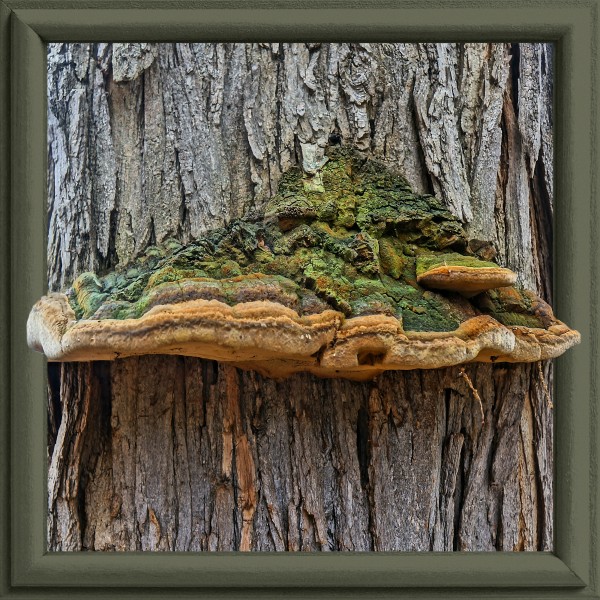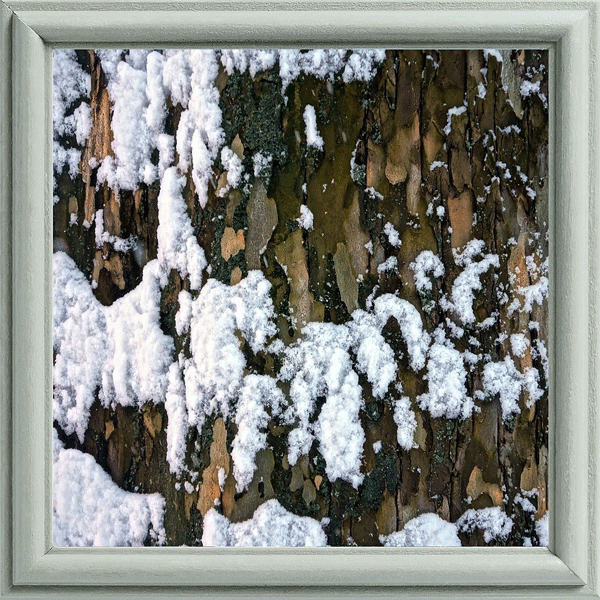The many passions of digital media artist Michael Tomb

(Cercidphyllum japonicum) in Rochester’s Highland Park.
By Michelle Sutton Images copyright Michael Tomb
Michael Tomb’s mesmerizing “Skin of the Arboretum” image series began in early 2008, on a tour of Rochester’s Highland Botanical Park Pinetum with horticulturist Kent Milham. Tomb became fascinated by both patterned and abstract expressions of bark on the trees; he now exhibits truly arresting photos and photo collages of them. As with “The Hobbiton of the Bark” (see photo), he frequently employs an element of trompe l’oeil in both the subject matter and the convincing, apparent picture frame.
Tomb identifies as a digital media artist, rather than a photographer. He has taken an average of 50 pictures a day over the last 15 years. Many of his images employ HDR (high dynamic range) software that takes multiples of an image and eliminates the “noise” from each one to get a wider range of exposure and maximum 3-D effect.
“Many of my finished images are not one photo—each is as many as 12 or 13 frames on top of or extending each other,” he says. “Virtually every image has been manipulated. I don’t believe in the idea that there’s a clean image that’s somehow sacred. All digital cameras are computers, after all, so a program is involved in any digital photography.”
He continues, “I’m after the image. I like to use any method available to me—so were many of the most famous film-based photographers. They often used analog tools such as filters on the camera or the enlarger and dodging and burning, even combining multiple images into one. I experimented with all those techniques back in my darkroom days. But the image still begins in my mind’s eye and works its way slowly towards a surface of some sort. There is no happy accident involved here; I know what I want and when the image finally lines up with my internal expectation, it’s finally done.”

trompe l’oeil in both the image and the “frame.”
The tour where “Skin” was birthed was organized for the Highland Park Neighborhood Association, an organization with whom Tomb and his wife Marcia, residents of the neighborhood, have been very active since 2006, when a fatal stabbing of a young person 300 feet from their door galvanized them.
Tomb says, “Marcia and I had a conversation. It was like, if we’re going to stay here, we need to get more involved. I’m a lifelong committed pacifist so I wasn’t going to suggest we get armed. The one thing I knew we could do was work toward giving the neighborhood a higher profile in arts and culture. I wanted us to make the neighborhood more special, with the hopes that that would help make it ultimately safer.”
Using his digital media skills, Tomb had been doing some volunteer work for New Orleans recovery post Katrina and had been heartened by the level of community action he saw there. He decided to invest these skills in earnest in his neighborhood, though he and Marcia still make frequent trips to their beloved New Orleans.
He says, “One of the first things we researched together was the urban planning concept called ‘Placemaking’. The residents themselves re-design their common public living spaces to make them more inviting and special. The results are places that the community creates and owns together. The idea is both old and new; in fact I discovered an article written in 1882 in one of Rochester’s most beautiful (if forgotten) horticultural journals, Vick’s Illustrated Monthly Magazine, that described what is now known as ‘Placemaking’. And when I republished it on our neighborhood’s online ‘Virtual Scrapbook’, links to it were retweeted by national experts who support the movement. This is now something I’m totally committed to as a way to develop cities.”

(Platanus x acerifolia) in Tomb’s Highland Park neighborhood.
Tomb’s mother’s family was based mostly in Rochester but at an early age, he experienced a huge cultural upheaval. His Sicilian grandfather, Frank Mully, a mason by training, had moved with his wife and family from Rochester to Bristol in the 1940s to live on a farm and eventually started that rural area’s first Italian restaurant, on Route 64. Tomb grew up on the attached farm, and growing vegetables with his grandfather kicked off a lifelong interest in gardening. After his grandfather Frank had a severe stroke, Tomb’s family literally moved into the restaurant building to help out, and thus commenced many years of Tomb’s immersion in the restaurant trade, of which he has happy memories.
Tomb’s mother, Gemma, was only one of two college educated members on either side of the family; she was passionate about music and the arts, and about science. “She could tell you the life history of all the great classical composers, and she could play the most rollicking version of ‘Sunny Side of the Street’ on the piano,” he says.
Gemma passed her love of the arts and sciences on to her children including her son, who in his teenage years developed passions for photography and astronomy. She also took an action that had hugely positive consequences for Tomb and his sister, who needed a more rigorous academic environment. Gemma Tomb approached the Harley School, an esteemed secular private school in Pittsford, with the result being that both children received full scholarships to attend. Tomb started at Harley in 1969 and finished in three years. “I got exposed to this amazing nurturing educational experience I wish so many kids could have,” he says.
Among the courses he took was filmmaking, and he even had after-hours access to the school’s refrigerator-size computer. Tomb used “unshielded radio noise” from the computer to score one of his animated films. He took to computer programming, eventually developing his own personal video games. In 1972 he started attending Franklin and Marshall College, because they had a strong Astrophysics program. He became the photo-editor of the college paper and continued to school himself in computer programming. In his senior year, he had a bit of an identity crisis and dropped out and returned to Rochester where he’d hoped to work as a photographer, but he spent more of his time evaluating choices in life and the result was a renewed desire to complete his education.
Eventually one of Tomb’s best friends at Franklin and Marshall, Paul Marttila, convinced Michael to go back to college and finish his degree. They are still close. Marttila says, “We connected through a shared sense of humor; I’m proud to call him one of my closest friends for 40 years. Michael is a brilliant guy, a renaissance man. In college, we would go camping with our friends and Michael, already at that phase an advanced astronomer, would spend hours describing constellations and planets in a way that was fascinating to us. In recent years, I’ve seen him give multimedia presentations on astronomy that were amazing.”

After graduating college, Tomb came back to Rochester and worked for two small computer scientific programming firms while continuing to practice his photography craft. As a requirement for designing one of the world’s first toxicity prediction systems, he expanded his training in computer graphics because of the need to represent and input molecular structures on the computer screen.
In 1992, he started his own consulting business, helping clients with their statistical, health science, and engineering computational and programming needs. “When I went out on my own, I felt as if I had just jumped from the end of a gangplank and before landing in the water, I had to learn how to swim,” he says. The first year was lean—they ate mass quantities of zucchini and Swiss chard from their garden that summer—but he’s now very much sought after for his skills in solving problems related to new technologies, including writing software.

Tomb’s one of those lucky people who is passionate about his work. He is also passionate about the horticultural history of Rochester and has launched a series called The City of Flowers Collection that he exhibited for the Highland Park Neighborhood Association.
“I found that there was this amazing series of printing companies employing hundreds of immigrant artists that did all this folk-ish, beautiful commercial botanical art, often unsigned. This was a flourishing industry here, one that handled the visual aspects of Rochester’s nursery and seed industries. Rochester invented a new kind of commercial art called ‘plates for the nurseryman’—a nursery rep would come to the lithographer and say, I need prints of these 200 varieties, and a book of lithographs would be put together. These compilations were like the precursors of seed catalogs.”
Tomb has been collecting, mostly from eBay, prints of this botanical art, along with trade cards and early seed catalogs, all printed and designed in Rochester. He scans or photographs the images, digitally restores them, and reproduces them at a bigger scale, which enhances the folk art and even pop art aspects of the images. “This isn’t something I seek to make money from,” he says. “I wanted to pay homage to these largely unknown, incredible folk artists.”
Tomb is also known for his work photographing Highland Park’s Lamberton Conservatory’s interior and exterior, including on those nights during the holiday seasons when the building is open one evening a week and festooned with lights. He hopes to publish a collection of these Conservatory photos.
The Skin of the Arboretum continues to be the series that gets the most attention. Friend and former colleague Pat Mann purchased prints of two of Michael’s fine art. She says, “I was so enamored and transfixed to the spot with two of his pieces from the Skin of the Arboretum at his opening that I just had to have them: ‘The Hobbiton of the Bark’ and ‘The Nude of the Bark.’”

She says, “‘Hobbiton’ just jumps out at you … Michael captured an artifact of nature in such a way as to evoke a magical essence. And ‘Nude’ reminds me of Jean Arp’s ‘Sculpture Classique’ (1960), capturing the female form in very sleek simple lines, but Michael’s art and technique is even more brilliant in extracting and showcasing it from nature. His addition of color gives the feeling of a cloaked figure, uncovered, revealing the female form. I just love it. I’m glad to see Michael is pursuing his fine art; his energy is boundless, and his passion is contagious!”
Tomb adds, “It took decades for these images to make it to my eye. I grew up in the rural Bristol Hills and many old trees, abandoned orchards, and pockets of isolated forests were like remote friends that I and my dogs visited alone. And yet it wasn’t until 30 years after I finally left Bristol that I really started seeing the surfaces of trees as beautiful abstractions. Now I can’t stop. To me the Arboretum within Highland Park is not just a collection of special trees and shrubs but these are open air rooms in a living museum of art.”
Michelle Sutton is a horticulturist, writer, and editor based in New Paltz, New York (michellejudysutton.com).


You must be logged in to post a comment.